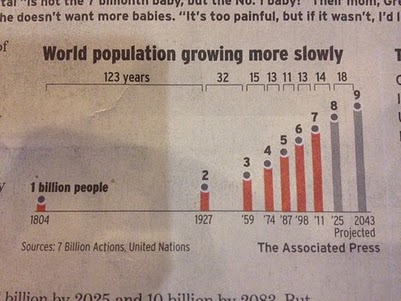Sometime on Monday, October 31, 2011, a Halloween baby was born. This special tyke is the 7 billionth human being living on our planet. An incredible number that shocks, interests, awes, and scares all of us.
Here are some interesting facts about this major milestone.
- Standing shoulder-to-shoulder all 7 billion of us would fill Los Angeles (so space is not the problem).
- Today there are 5 births for every 2 deaths.
- We speak 7,000 languages.
- And, we live in 194 countries.
Now, get ready for this. We are not going to stop at 7 billion, with many experts predicting that we will peak at around 9.5 billion sometime in the middle of this century (~2050).
Which brings up a whole slew of questions. First, food, where agriculturists expect “supplying food for nine to ten billion people will not be an issue.” Though, distribution will undoubtedly continue to be a problem.
Second, how are all of these people going to live. The trend is a massive urbanization of the world’s population. Our cities have grown to titanic sizes with the current unit of measurement being 10 million or more residents, called a megacity.
Keep in mind that up until the industrial revolution in the early 1800s, no city in the world ever had more than a million and change. As the revolution took hold, cities like London and New York quickly sprouted up to 10 million and beyond.
Today, there are 26 megacities with the 10 largest having populations beyond 20 million. Before this growth is complete another 25 will join the ranks.
Imagine that, a world with 50 megacities. Should make for some exciting travel opportunities. Here is how they will likely be spread out:
- 8 in China
- 6 in the US
- 6 in India
- 6 in Latin America
- 4 in Africa
- 3 in Japan
- 3 in Europe
Though, as the world matures we might see some drastic changes. For example, if Africa gets on the right track it could quickly become the new growth zone.
Which brings up the third topic: growth areas. It shouldn’t surprise anyone that most of Europe isn’t growing. The majority of its country’s have reached their ideal population size, with growth rates steady or even slightly shrinking.
Now compare that to the fastest growing countries who will be doubling their population in the next 15-20 years: Liberia, Burundi, Afghanistan, Western Sahara, and East Timor.
The demographers have noticed this too and concluded the following. First world economies have already reached their peak population, the fast-risers like India and Brazil are booming, and the third-world countries have yet to experience their growth.
Modern medicine, sanitation, and capitalism have yet to reach certain areas of the world.
Here is a graph from Google’s Public Data Explorer which highlights this trend.
The United States is still booming (0.97%) despite being a first-world economy, and China is not with a growth rate (0.48%) half that of the United States and very close to the European rates.
The overall world growth rate is 1.17%.
Some of the growth rates around the world:
- Japan: -0.02%
- Germany: -0.07%
- Russia: -0.051%
- Italy: 0.12%
- Sweden, France, UK, Switzerland, Austria, Belgium: less than 0.48%
Countries with the world’s largest populations:
- China – 1.34 billion
- India – 1.21
- United States – 0.31
- Indonesia – 0.24
- Brazil – 0.19
And, their growth rates:
- China – 0.48%
- India – 1.46%
- United States – 0.97%
- Indonesia – 1.16%
- Brazil – 1.26%
Fourth, and final point involves the sustainability of all these people. We can barely keep this planet functional with 7 billion people, so imagine how much worse everything will get with 2.5 billion more people.
The good news is that many places in the world are working hard to create sustainable cities in tune with nature and civilization. The place where I live, Huntington Beach, is one such example.
They have created a space for endangered birds and marine life which also serves as a stormwater run-off cleanser. The result is a booming wildlife population alongside a burgeoning surburban population, both living sustainably together.
Even more these moves are saving the city money and reducing the taxpayer burden, through a combination of community involvement and non-profit management.
As we move forward and another billion children are born, there will be a growing need for more of these win-win sustainable solutions.

